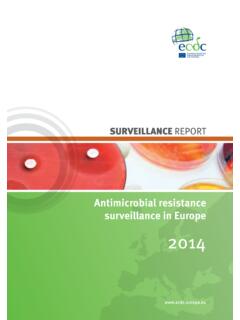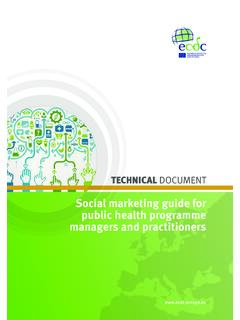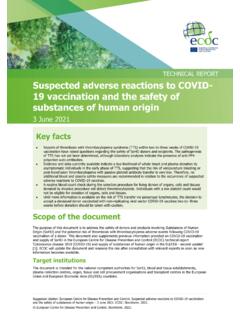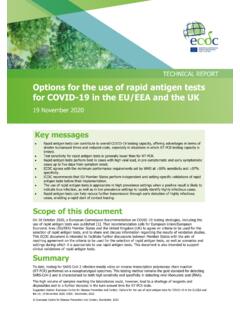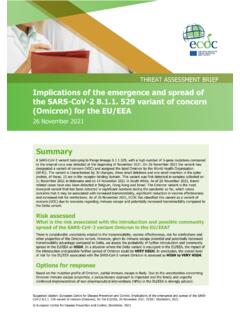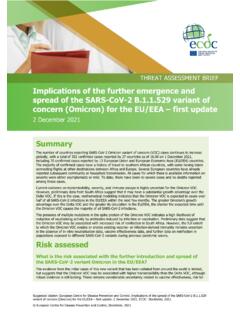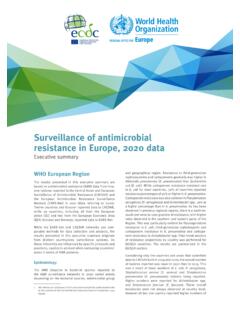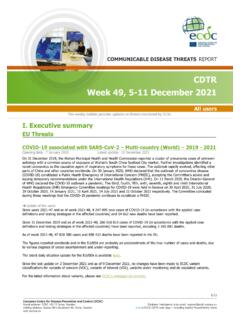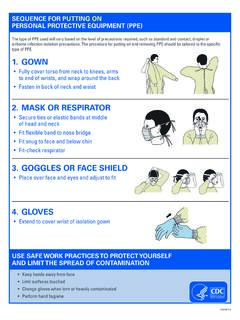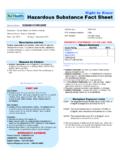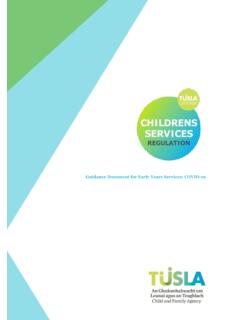Transcription of Use of gloves within COVID-19
1 Suggested citation: European Centre for Disease Prevention and Control. Use of gloves in healthcare and non-healthcare settings in the context of the COVID-19 pandemic. ECDC: Stockholm; 2020. European Centre for Disease Prevention and Control, Stockholm, 2020 TECHNICAL REPORT Use of gloves in healthcare and non-healthcare settings in the context of the COVID-19 pandemic 2 July 2020 Scope of this document This document aims to provide scientific evidence and guidance for healthcare settings and the public on using gloves as a preventive measure during the COVID-19 pandemic.
2 Wearing gloves outside the context of COVID-19 for personal protection and mandated by relevant regulations in occupational settings such as in industrial applications or in the food or pharmaceutical industry to avoid contamination of products is outside the scope of this document. Target audience Public health authorities in EU/EEA Member States and the United Kingdom. Key messages In the community There is currently insufficient evidence to recommend the regular use of gloves as a preventive measure in the context of COVID-19 to the public and to people in most occupations.
3 Use of gloves in the community may lead to the misconception that hand hygiene practices can be neglected. Regular use of gloves may confer the risk of dermatological side effects. The generation of waste from unnecessary glove use causes environmental damage. In healthcare settings The use of medical gloves is recommended as part of standard precautions to reduce the risk of contamination of healthcare workers hands with blood and other body fluids including contact with non-intact skin and mucous membranes. When indicated, use of medical gloves is recommended as part of contact precautions, to reduce the risk of pathogen dissemination to the patient s environment, to other patients and for the protection of healthcare workers.
4 Taking into consideration the currently available types of gloves for use in healthcare settings, extended use, decontamination and reuse of single-use medical gloves is discouraged. In the event of shortages, single-use medical gloves should be prioritised for use in healthcare settings. TECHNICAL REPORT Use of gloves in healthcare and non-healthcare settings in the context of the COVID-19 pandemic 2 Background On 31 December 2019, a cluster of pneumonia cases of unknown aetiology was reported in Wuhan, Hubei Province, China. On 9 January 2020, China CDC reported a novel coronavirus as the causative agent of this outbreak.
5 The virus is phylogenetically in the SARS-CoV clade and called severe acute respiratory syndrome coronavirus 2 (SARS-CoV-2). The disease associated with the virus is referred to as coronavirus disease 2019 ( COVID-19 ). As of 23 June 2020, 1 518 251 cases have been reported in the EU/EEA and the UK, including 174 968 deaths [1]. The majority (90%) of EU/EEA countries and the UK are currently observing much lower 14-day incidence rates compared to the peak which occurred from 2-23 April 2020, depending on the country. All countries are in the process of adjusting their containment measures, with the potential risk of increases in case numbers, depending on continued compliance with physical distancing, respiratory and hand hygiene as well as the intensity of testing and contact tracing.
6 Detailed information on the COVID-19 cases reported so far are available on a dedicated ECDC webpage [1]. More up-to-date disease background information is available online (ECDC [1], WHO [2]) and from the latest ECDC Rapid Risk Assessment [3]. In most instances, coronaviruses, including SARS-CoV-2, are transmitted from person-to-person through large respiratory droplets produced during normal conversation or when coughing and sneezing, either by inhalation or deposition on mucosal surfaces. Other routes implicated in transmission of coronaviruses include contact with contaminated fomites ( frequently touched surfaces) and inhalation of aerosols produced during aerosol generating procedures (AGPs).
7 Viral RNA has also been detected in blood and faecal specimens, but there is no evidence of transmission through contact with blood and the role of faecal-oral route is still unclear [3,4]. The relative contribution of droplet, fomite and aerosol to the human-to-human SARS-CoV-2 transmission is still under investigation. Types of gloves There are many different types of gloves used to protect hands from occupational hazards and as a means of providing a sterile skin cover for specific tasks. They can be multiuse or disposable. Their material depends on the intended use.
8 This guidance does not discuss protective gloves that are used outside of the scope of protection from contamination by biological hazards, such as those for mechanical risks, thermal hazards, chemical hazards, food handling or in the pharmaceutical industry. Figure 1. Different types of gloves (from left to right, light latex or nitrile gloves , intermediate thickness, heavy duty gloves ) [5] Medical gloves are used in healthcare settings during various procedures to prevent contamination between patients and healthcare providers. Medical gloves are either examination gloves that may or may not be sterile, and surgical gloves that are mostly used during various medical procedures and surgical operations and are sterile.
9 Medical gloves in EU/EEA countries should comply with requirements defined in the Council Directive 93/42/EEC [6] concerning medical devices and the Regulation (EU) 2016/425 [7] relating to personal protective equipment. The European Standard EN 455 on medical gloves for single use specifies requirements for the quality of medical gloves . Standards and specificities for the gloves used in microbiological and biochemical laboratories are described in the European Standard EN ISO 374. TECHNICAL REPORT Use of gloves in healthcare and non-healthcare settings in the context of the COVID-19 pandemic 3 Single-use medical gloves are made of different materials (including but not limited to latex, nitrile rubber, polyvinyl chloride (PVC), polyethylene and neoprene), and have different colours, thickness, sizes, and versions ( long- and normal-cuffed, powdered or powder-free) (Figure 1) [5].
10 The choice of gloves balances tactility ( for medical interventions) and the level of protection (defined by mechanical resistance). The choice of the glove size plays a crucial role in increasing the tactility. The most frequently used type of medical gloves include powder- free latex and nitrile gloves . gloves used for household activities in the community ( gloves made from natural latex, nitrile, vinyl and polyethylene) most commonly do not meet the standards described for medical gloves that are used in healthcare. Use of gloves by the public in the context of COVID-19 transmission In the community, the recommended measures to mitigate the spread of COVID-19 are physical distancing, adherence to a respiratory etiquette and meticulous hand hygiene; and use of face masks in areas where there is community transmission and in settings where physical distancing cannot be guaranteed.
